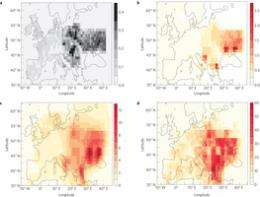January 7, 2013 report
Research shows isoprene from biofuel plants likely to lead to ozone deaths

(Phys.org)—A trio of researchers from the Lancaster Environment Centre, in the UK has found that planting trees for use as a biofuel source, near populated areas, is likely to increase human deaths due to inhalation of ozone. The team, in their paper published in the journal Nature Climate Change, suggests that increased levels of isoprene emitted from such trees, when interacting with other air pollutants can lead to increased levels of ozone in the air which might also lead to lower crop yields.
To reduce the amount of carbon dioxide being released into the atmosphere due to the burning of fossil fuels, governments and private groups have turned to biofuels as an alternate source. In Europe, fast growing trees such as eucalyptus, willow and poplar, have been planted and are being used to create biofuels which can be burned in engines and generators. Such trees have been seen as an attractive alternative to other edible crops, such as corn, because growing them doesn't impact the price of food. Now however, this new research suggests that there is a different price to pay when using trees to produce biofuels.
The problem, the researchers say, is that the types of trees used to produce biofuels emit high levels of the chemical isoprene into the air. Prior research has shown that when isoprene mixes with other pollutants (such as nitric oxides), ozone is produced. In this new research, the team suggests that using such trees as a biofuel could result in up to 1,400 deaths per year in Europe – per the European Union's 2020 tree planting goal – attributable to increased amounts of ozone in the air, along with $7.1 billion in additional health care costs and crop losses.
Plans for using trees as a biofuel resource generally involve planting near large urban areas to avoid incurring transportation costs. Such plantings, the researchers suggest, would lead to lung problems and deaths for people living in those areas. Conversely, if large numbers of such trees were planted in rural areas, edible crops would be adversely impacted, leading to less production and higher costs.
The team also notes that ozone is currently blamed (by the European Environment Agency) for the deaths of 22,000 people in Europe each year.
More information: Impacts of biofuel cultivation on mortality and crop yields, Nature Climate Change (2013) doi:10.1038/nclimate1788
Abstract
Ground-level ozone is a priority air pollutant, causing ~ 22,000 excess deaths per year in Europe, significant reductions in crop yields and loss of biodiversity. It is produced in the troposphere through photochemical reactions involving oxides of nitrogen (NOx) and volatile organic compounds (VOCs). The biosphere is the main source of VOCs, with an estimated 1,150 TgC yr−1 (~ 90% of total VOC emissions) released from vegetation globally4. Isoprene (2-methyl-1,3-butadiene) is the most significant biogenic VOC in terms of mass (around 500 TgC yr−1) and chemical reactivity and plays an important role in the mediation of ground-level ozone concentrations5. Concerns about climate change and energy security are driving an aggressive expansion of bioenergy crop production and many of these plant species emit more isoprene than the traditional crops they are replacing. Here we quantify the increases in isoprene emission rates caused by cultivation of 72 Mha of biofuel crops in Europe. We then estimate the resultant changes in ground-level ozone concentrations and the impacts on human mortality and crop yields that these could cause. Our study highlights the need to consider more than simple carbon budgets when considering the cultivation of biofuel feedstock crops for greenhouse-gas mitigation.
Journal information: Nature Climate Change
© 2013 Phys.org














